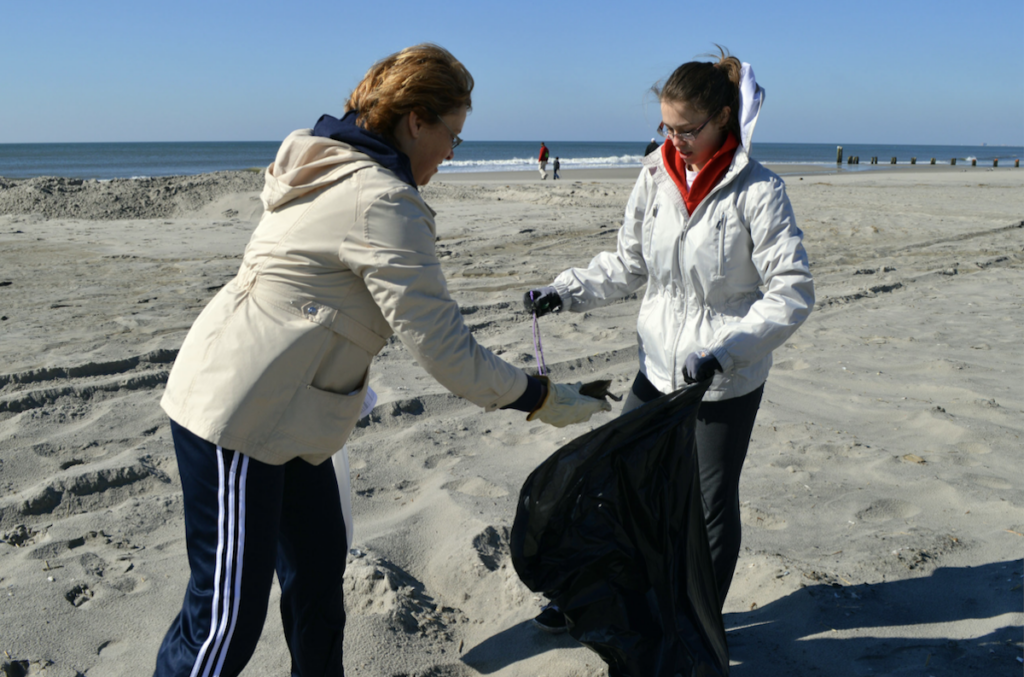40 Years Of Cleaning The Coast
The nonprofit clean ocean action can’t say its beach sweeps have cleared Jersey beaches of “everything but the kitchen sink.” (Because they have found that too.)

A cool, overcast day in April doesn’t usually mean bustling beaches. But on April 12 of this year, New Jersey’s beaches and watersides were alive with thousands of volunteers. From Bergen County’s Englewood Cliffs to the tip of Cape May and from Aberdeen down to Sea Girt in Monmouth County, people took to the sands with buckets, bags and data cards to clean up debris and trash from our coastlines. That occasion was a Beach Sweep, one of the signature programs of the Long Branch-based nonprofit Clean Ocean Action (COA). Marking their 40th anniversary this year, the twice-yearly Beach Sweeps constitute one of the longest-running coastal cleanup initiatives in the world—and one of the most effective. The next one will be held Oct. 18.
The first Beach Sweep gathered a group of 75 volunteers in Sandy Hook in 1985. The program has since bloomed into a statewide initiative that includes the Raritan Bay and the Delaware Bay in addition to the Atlantic coastline. Volunteers gather in the morning at local beaches under the supervision of a “beach captain” (also a volunteer) and, while checking in, are given a data card on which to log the kinds of debris and trash they pick up.
That card is at the heart of what makes the program influential. Says Meg Sulzberg, the “plastic-free sea” coordinator at COA and the main coordinator of the Beach Sweeps program: “We keep a long-spanning database of what is logged. We use that data, first and foremost, to track pollution trends within New Jersey. But it’s also used to inform policy at a local, state and sometimes even national level.”
For instance, enactment of New Jersey’s Get Past Plastic law, which took effect in May of 2022 and bans single-use plastics such as plastic carry-out bags and Styrofoam takeout containers, was influenced by the data collected over years of Beach Sweeps. “Plastics, particularly small plastics, are always a problem and we always collect a lot of them,” says Sulzberg. “But, when we process the data, we really are seeing a decrease since the law was passed. It’s a huge step.”
That logging of exactly what is pulled from the sand has also led to some of Beach Sweep’s most memorable moments. “People find all sorts of weird things,” says Sulzberg. “There’s stuff you’d expect—umbrellas, chairs, boogie boards and beach toys—but this spring, multiple people found whole, unbroken watermelons. In 2024 someone found a bowling ball. Someone else found a whole kitchen sink.”
What do volunteers pick up the most of? Says Sulzberg: “Last year, our No. 1 found item was bottle caps. They fit through the spokes of the machines used to clean the beaches, so that might be why. They are always a part of our ‘dirty dozen,’ or 12 most found items every year.” The dirty dozen in 2024 also included plastic pieces, food and candy wrappers, foam pieces, straws and stirrers, cigarette filters, plastic beverage bottles, miscellaneous other plastics, plastic cap rings, cigar tips, metal drink cans and paper pieces.
Over the program’s 40 years, more than 176,000 volunteers have contributed over one million hours to the cause, removing 8.7 million pieces of debris from New Jersey’s shores, per COA’s data. “There’s a huge sense of teamwork among the volunteers,” says Sulzberg. “It’s really become a tradition for some people. This past spring, I met two volunteers who have been coming for all 40 years. They couldn’t stay long, but it was important to them to make it. This is their community.”
And that sense of community, says Sulzberg, is part of the reason Beach Sweeps remain effective. “It’s inspiring to see how many people come out,” she says. “People from New Jersey really care about the Jersey Shore. Beach Sweeps aren’t just about cleaning trash. They’re about creating a legacy—showing future generations that we stood up and made a difference for them.”

